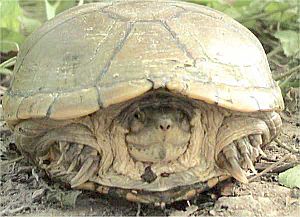Yellow mud turtle facts for kids
Quick facts for kids Yellow mud turtle |
|
|---|---|
 |
|
| Conservation status | |
| Scientific classification | |
| Genus: |
Kinosternon
|
| Species: |
flavescens
|
| Synonyms | |
|
|
The yellow mud turtle (Kinosternon flavescens) is a small turtle often called the yellow-necked mud turtle. It belongs to a group of turtles known as mud turtles. You can find these turtles only in the Central United States and Mexico.
Contents
Where Yellow Mud Turtles Live
Yellow mud turtles live in many different places. They are found in both the United States and Mexico.
In Mexico
In the United States
It's not fully clear if they still live in Veracruz (Mexico) or Arkansas (United States).
What Yellow Mud Turtles Look Like
The yellow mud turtle is a small turtle with an olive-colored shell. Its name comes from the yellow areas on its throat, head, and sides of its neck. The scientific name, flavescens, also means "yellow" in Latin.
The bottom part of its shell, called the plastron, is yellow to brown. This turtle has two hinges on its plastron. This special design lets the turtle close both the front and back parts of its shell. This helps it protect itself from danger.
You can tell male and female yellow mud turtles apart by their tails. Males have a short, blunt spine at the end of their tail. Females do not have this spine.
Lifespan of the Yellow Mud Turtle
Yellow mud turtles can live for a very long time. Some of these turtles have been known to live for more than 40 years!
What Yellow Mud Turtles Eat
Yellow mud turtles are omnivores. This means they eat both plants and animals. They have a varied diet, which helps them find food in different places.
Favorite Foods
- Worms
- Crayfish
- Frogs
- Snails
- Fish
- Fairy shrimp
- Slugs
- Leeches
- Tadpoles
- Other water insects and invertebrates (animals without backbones)
They also eat plants and dead or decaying matter they find.
How They Find Food
Yellow mud turtles look for food both on land and in the water. In early spring, they mostly eat fairy shrimp. They find these tiny creatures in the shallow parts of ponds. When they dig into the ground, they might eat earthworms or grubs they come across. Some studies even suggest they might eat earthworms that pass by them while they are hibernating.
Reproduction and Life Cycle
Yellow mud turtles have a unique way of caring for their eggs. Most female water turtles dig a nest, lay their eggs, and then leave. But yellow mud turtles are different.
Parental Care
They are the only type of turtle known to stay with their eggs for a while. A female turtle lays a clutch of 1 to 9 eggs. She then stays near the eggs for a few hours, or sometimes even up to 38 days! Scientists believe she stays to keep predators away from her eggs.
It has also been seen that female turtles will urinate on their nests during dry years. This is thought to help the eggs hatch successfully when there isn't much rain.
Hatching and Survival
In their natural homes, spring rains seem to make the turtles start nesting. The eggs usually hatch in the fall. Some baby turtles leave the nest right away and spend the winter in water. However, most of the hatchlings dig deeper below the nest. They wait there until spring to come out and move to the water.
This waiting period helps the baby turtles survive. Some water bodies can freeze completely solid during winter. By waiting until spring, the hatchlings enter an environment with more warmth, light, and food, which helps them grow stronger.
See also
 In Spanish: Tortuga de pantano amarilla para niños
In Spanish: Tortuga de pantano amarilla para niños


